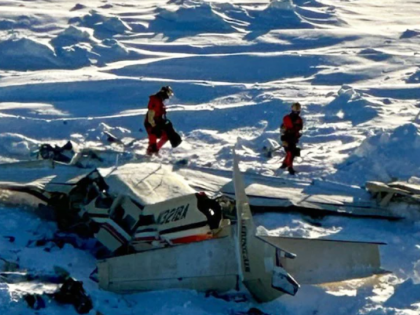Alaska Plane Crash: Missing Bering Air Flight Found on Sea Ice, All 10 Aboard Dead
By Lokmat English Desk | Updated: February 8, 2025 10:29 IST2025-02-08T07:40:08+5:302025-02-08T10:29:01+5:30
A Bering Air commuter plane with 10 people aboard was found crashed on sea ice off western Alaska on ...

Alaska Plane Crash: Missing Bering Air Flight Found on Sea Ice, All 10 Aboard Dead
A Bering Air commuter plane with 10 people aboard was found crashed on sea ice off western Alaska on Friday. All nine passengers and the pilot were killed, authorities confirmed.
UPDATE: U.S. Coast Guard says no survivors in Alaska plane crash, 10 killed - ADN https://t.co/eQ8YbntZJh
— BNO News (@BNONews) February 7, 2025
The plane, a Cessna Caravan, went missing while en route to Nome and was located about 12 miles offshore, 30 miles southeast of Nome. The U.S. Coast Guard discovered the wreckage during an aerial search near the aircraft's last known location. Two rescue swimmers were deployed to examine the wreckage.
Radar data from the U.S. Civil Air Patrol indicated that the plane experienced a rapid loss of altitude and speed around 3:18 p.m. Thursday. However, the cause of the sudden descent remains unknown. Lt. Cmdr. Benjamin McIntyre-Coble of the U.S. Coast Guard said that while radar data shows a sharp descent, the exact cause has not been determined. He added that no distress signals were received from the aircraft before the crash.
The Cessna Caravan, a single-engine turboprop, was at full capacity with nine passengers and the pilot. The plane had departed Unalakleet at 2:37 p.m. on Thursday for a regularly scheduled commuter service. At the time of the incident, the National Weather Service reported light snow, fog, and temperatures around 17°F (-8.3°C). Western Alaska is known for its sudden snow squalls and high winds, which can present serious challenges for small aircraft.
Search efforts involved local, state, and federal agencies, with Bering Air planes assisting in grid-pattern searches along the coastline. The Coast Guard's MH-60 Jayhawk helicopter first spotted the wreckage on sea ice and deployed rescue swimmers to investigate. Authorities have not confirmed if the plane's emergency locator transmitter (ELT) was activated. The device is designed to send distress signals upon impact or water exposure, but no alerts were received by the Coast Guard.
The crash is the third major aviation mishap in the U.S. in the past eight days. On January 29, a commercial jetliner and an Army helicopter collided near Washington, D.C., killing 67 people. Another crash occurred on January 31 when a medical transport plane crashed in Philadelphia, killing six passengers and one person on the ground.
The community of Nome, a historic Gold Rush town and the final stop of the Iditarod sled dog race, is now grieving the tragedy. Prayer vigils were announced to honor the victims, their families, and the first responders involved in the search.
U.S. Senators Lisa Murkowski and Dan Sullivan, along with U.S. Representative Nick Begich, expressed their condolences. Begich posted on social media offering assistance to Governor Mike Dunleavy in supporting Nome and the affected families.
Air travel is essential in Alaska, especially for remote communities, but harsh winter conditions and rugged terrain increase aviation risks. Bering Air serves 32 villages from hubs in Nome, Kotzebue, and Unalakleet and typically operates twice-daily flights to most destinations.
(Inputs from AP)
Open in app